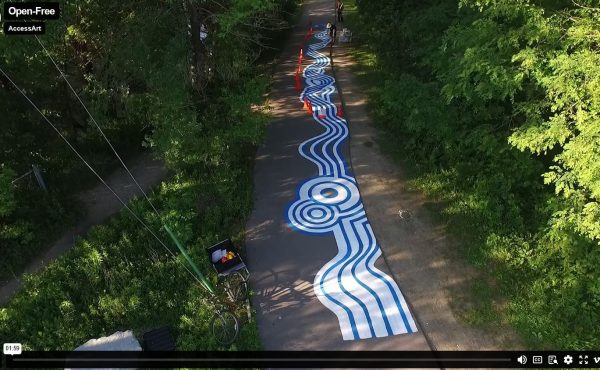HiMY SYeD is sending daily reports from the World Urban Forum to the Spacing Wire. Here is his second report.

7:43 am and it is standing room only at today’s first ‘side event’ – ‘One small step for cities, one giant leap for the planet: Practical solutions for cities stepping towards a lighter footprint’
A quick headcount reveals one hundred people present plus media who’ve turned out to chill with ‘Dr. Doom’ otherwise known as ‘Dr. Content’. UBC Professor William Rees is founder of the Ecological Footprint approach. His powerpoint slides illustrate practical ways cities can reduce their consumption patterns. He sprinkles his talk with stories of progress –though not success– and the body language of the room confirms that on this single issue of sustainable production, we’ve all drunk the Kool Aid.
The bad news?
“Many of your children may be farmers…” says Professor Rees.
Torontonians need only look down the 401 to Motown. Detroit is the first major industrialized city in history reverting its hollowed-out urban centre back to active farmland. Oops. Suddenly, it ain’t our kids who are becoming farmers.
How did we get here? Rees reminds us that today’s consumer society is a social construct of the post-war advertising industry. Consequently, “Consumption [has become] a modern religion. Today’s ‘Throwaway Society’ would consider my mom’s habit of saving a glass jar and re-using that jar again and again just plain weird,” Rees muses.
Are there any examples of good sustainable cities? Rees is not aware of any.
The most ecological cities still have a rising GNP/GDP confirming that, “Globalization prevents us from creating sustainability.” The key problem though is surprisingly paradoxical, the real challenges include for example, convincing the Mayor of Lagos (Nigeria) that his city is consuming ‘too little’. The real challenge is to, “convince them of creating sustainable cities” out of cities comprised of slums. Our ‘Throwaway Society’ keeps them unconvinced.
(China’s cities are the true real problem. I’ll return to this question in a later spacing wire report.)
However, “micro-examples of sustainability” do exist. Turin, Italy has “micro-utilities” and “micro-technologies” to generate power for its residents rather than giant power plants.
Here in West End Vancouver, a high concentration of rental units translates into 133 housing units per hectare (Scarborough, North York and Etobicoke average 15 units), it is little wonder that 60% of West End residents are cyclists compared with 89% daily car use by residents of Vancouver’s Maple Ridge suburb. Oh yeah, the ‘D’ word again — Density. It is mandatory for sustainable smart growth.
Cuba experienced its own “mini-peak-oil” event after the collapse of the Soviet Union and Russian food imports stopped suddenly. Result being that today 70% – 80% of all leafy vegetables consumed in Havana are grown within the “urban hinterland”, ie within Havana’s city limits.
Rees likes my definition of ‘Glocalization’ which I raise during the Q&A. Glocalization is the city-state being replaced by the neighbourhood-civilization.
I ask Professor Rees if he can think of any micro-examples of reducing the ecological footprint at the neighbourhood level. Dr. Content doesn’t disappoint. “Yes, have you heard of the 100 Mile Diet?”. A collective of people in Vancouver have committed to consuming food which is only grown within a 100 mile radius of their neighbourhood and no more, thus reducing the ecological footprint of the food they eat from a global footprint to a local one. Instantly I think of Dufferin Grove Park’s Farmers’ Market and ask if he knows of any operating “‘100 Mile’ farmers’ markets?'” He hasn’t.
The Friends of Trinity-Bellwoods Park are currently looking into bringing a farmers’ market to their downtown park and are researching how to differentiate theirs from the nearby Dufferin Grove one on Thursdays. Hmmm….
After the side event ends, Dr. Rees and I continue the discussion as we walk through security checks heading towards a special lecture, ‘The Wealth of Cities: Towards an Assets-based Development of Urban Regions’.
The good news?
…Many of our children may be farmers.
HiMY SYeD World Urban Forum 3, Vancouver




5 comments
Thanks for the report Himy, there’s some material for thought there. I love your idea of a 100 mile market too.
Actually, I quite like the prospect that our children (or we) may have the option be inner-city farmers, sure beats call centre fodder.
YAY!!! Urban farming!!!
I was at a toronto parks public consultation meeting last night and my group all thought community gardens were something that the City needs to invest in.
beyond community gardens. I was (until recently) working with Solomon Boye at the City of Toronto in establishing an urban organic farm near Jane and Steeles. 8 acres of tableland owned by the TRCA, managed by the City. last year they put in the fencing, gates, curb cuts, a couple of sheds, irrigation. they hired 10 kids who hand tilled the land 3 times over. now the money has run out and the land sits under black plastic. a number of community orgs have shown interest, but it’s a really rough place to be taking volunteers… I’m not talking about the reputation of the neighbourhood. I mean there is no shelter. there is no toilet. no hot water. no electricity.
some of this stuff you can kind of do without, but no shelter and no toilets is a bit harsh. last summer they had port-o-potties and a few picnic tables under the trees, but it was not a good situation.
there is a “farmhouse” next door that the TRCA has been leasing out as a residence and there has been some discussion about the City taking over this property. however I understand that the TRCA wants to keep leasing out the property for revenue generation and the City needs to consider what upgrades they would need to do to the building if they were to take it over and open it up to the public. toilets, again, are a big hang up. the farmhouse is currently on a septic system so they would need to install a sewer hookup possibly from across 6 lanes of Jane street. that’s a lot of $$$$.
anyone have $?00,000 to donate to this project? ideas for composting toilets? it could be such a great project, it makes me weep to think it might sit fallow this year. it’s getting so late in the planting season, I don’t know that a whole lot can be dont at this point.
let me know if you want to go for a site visit.
k
As for the urban farm in joint partnership with the City and TRCA, it sounds like they need one person working on fundraising and donations.
Community gardening is great (I’ve founded and run a community botanical garden in New York City since 1984) but the 750 community gardens in NYC have had a tough time of it, having to stand up to the all-powerful real estate lobby. They own everything and everybody. And the minute that community gardeners move into a bad neighborhood and make it livable, the real estate interests move in. Let’s get real here. You can’t have urban gardening without seeing and addressing the whole picture. http://www.ringgarden.org
With the mention of the Dufferin Grove Farmer’s market and the comment about the Composting Toilet solution suggested for the urban farm I got excited.
Dufferin Grove is currently building an earthen structure to house the class one composting toilet donated to the park last year.
However we are banging our heads against bureaucratic roadblocks, despite the City’s Art Council funding the project, and both the toilet and building being permit exempt. (The building is under 100 sq ft and the toilet (surprise surprise) has no plumbing). Now they are insisting that workboots, gloves and googles be worn behind the 6ft fence on the building site.
Maybe not such a problem if the building were being made with conventional methods. However, it is to be a Cob structure, (straw, sand and clay mixed with bare feet and applied by hand). We have also lost a chunk of our much needed volunteer base, as children cannot cross the fenceline.
It seems we may make a smaller footprint with the final toilet, but the red tape and paper used up in the building/stalling process could possibly cancel out the saved water and energy. 🙂
Any ideas? Maybe people who understand the Ontario Building/Safety laws and know of exemptions for earthen building or community built structures.
Thanks